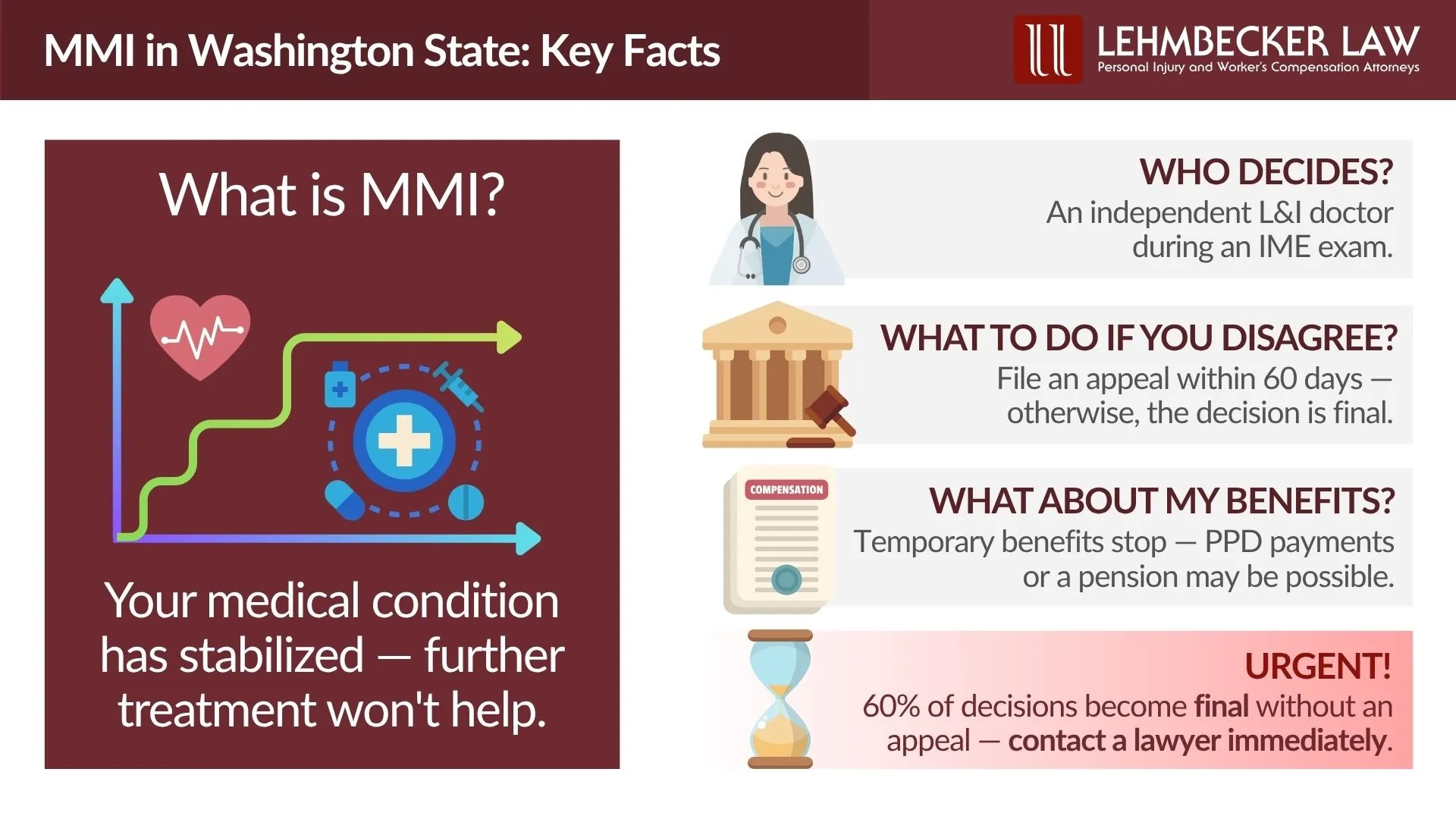There is no fee unless we win!
EN

- EN
- ES


In Washington, a workplace injury claim must first be approved by the Department of Labor and Industries (L&I). After it’s accepted, your case enters the active stage. For the vast majority of work-related injuries, the worker receives treatment, recovers completely, and returns to their full-time job. Any wage loss is paid, the medical bills are covered, and the claim is closed.
But for some injured workers, though, their work-related injury is severe enough that the symptoms continue for an extended period of time, or their condition (and related disability) is actually permanent. If this happens to you, at this point, you’ll receive medical care for the injury or illness connected to your job until your condition reaches maximum medical improvement (MMI). This point indicates it has stabilized, and further medical treatment is unlikely to provide a substantial recovery.
In this blog post, our WA workers' compensation attorneys explain what maximum medical improvement means for your case, how it is determined, and how it affects your workers' compensation benefits.

Under Washington’s Industrial Insurance Act, injured workers are entitled to medical care necessary for conditions linked to their claim. This includes both curative care to improve or resolve the injury and rehabilitative care to restore long-term function and activity.
Maximum medical improvement (MMI) occurs when no further marked change in a condition can be expected, regardless of whether additional medical treatment is provided.
This doesn’t mean you are fully recovered from your workplace injury. Instead, it signifies that the claims examiner determined, based on the statement by the rating or treating physician, that additional medical services wouldn’t lead to meaningful improvement in your medical condition. For example, a worker suffers from a severe back injury that requires surgery.
Once an injured worker has reached maximum medical improvement, the focus shifts from actively treating the condition to managing any resulting permanent impairment and disability.

L&I or a self-insured employer can require an independent medical examination (IME) to determine whether you’ve reached maximum medical improvement. An independent rating physician reviews your medical history, conducts a physical evaluation, and then prepares a report. Copies of this report are sent to you, your doctor, your employer, and L&I or the self-insurer.
Sometimes, workers are asked to undergo a functional capacity evaluation (FCE), which assesses their ability to perform the physical demands of their job. The results help determine whether they can safely return to work or if their injury prevents them from performing their usual duties.
There is an exception to the MMI rule for terminal employees whose illness has not reached MMI. If medical evidence shows the worker is terminal, the illness will still be included in the impairment rating to preserve eligibility for an award.
When a worker has more than one covered illness, the claims examiner can issue an impairment rating for any condition that has reached MMI. However, if multiple illnesses affect the same organ or body function and at least one isn’t at MMI, it should be waited until all related conditions have stabilized before making a decision.
If your treating physician agrees with the IME findings, your temporary workers’ compensation benefits will end either on the date of the exam or the day your doctor signs off on the report.
If your treating doctor disagrees with the findings, you can protest to L&I or appeal to the Board of Industrial Insurance Appeals (BIIA). The BIIA is the state's independent agency that handles workers' comp disputes.
If your worker's condition deteriorates after the claim is closed, Washington workers' compensation law allows for reopening the case. You must show with medical evidence that your accepted condition has worsened beyond what is expected.
The time it takes to reach MMI depends on the type and severity of the injury or illness. Doctors use workers’ compensation guidelines to provide appropriate care, which often includes:
Serious injuries may require a longer recovery period, and disputes or claim delays can also postpone the official determination of MMI.

Some people ask, “What is a maximum medical improvement settlement?” As you can see, an MMI payout isn’t a separate benefit.
Once you reach MMI, your temporary wage-replacement benefits stop. What happens next depends on your medical status:
Unlike many other states, Washington doesn’t allow typical lump-sum settlements that close your claim entirely. Instead, in some instances, injured workers aged 50 or older with an approved L&I claim that has been pending for at least 180 days may apply for a Claim Resolution Settlement Agreement (CRSA).
The workers' compensation system can be difficult to manage alone, especially with MMI determinations and benefit transitions.
At Lehmbecker Law, our Seattle workers’ comp attorneys have experience helping injured workers secure the benefits they deserve. Whether you need to challenge an MMI determination, negotiate a workers' compensation settlement, or ensure you receive ongoing medical care, we can help. Contact us today for a free consultation about your workers' comp case.

Our Seattle workers’ comp attorneys will help you understand your options and the best way forward. Schedule a free consultation to get started.